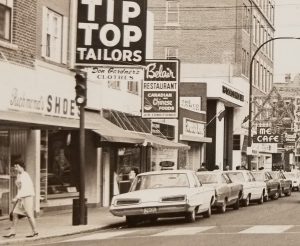Student researchers at Brandon University are putting together a labour history exhibition to mark the centennial of the 1919 Winnipeg General Strike and Brandon Sympathy Strike and they are casting a wide net to find new photos and other visual materials.
The exhibit will be displayed in the Brandon General Museum and showcased in Winnipeg for the 1919/2019 conference this May as well as making appearances in other venues in the city.
While the Winnipeg General Strike and the Brandon Sympathy Strike centennials are major inspirations for the exhibition, the researchers are balancing this content with considerable information on other major moments in Brandon’s labour history. And they need the public’s help to do this.
“While we have found many amazing resources to help us tell these stories, we still need a number of photographs to round out coverage. Pictures having to do with Brandon area strikes — the Brandon Sympathetic Strike of 1919, the Packer’s Strike of 1960, and the McKenzie Seeds Strike of 1944 — would be preferable, but anything in that general area would be excellent as well,” said Jenna English, who is one of the two student researchers working on the project.
“Any historic labour photos would be lovely,” she said, “but also photos of those opposing the strikers or labour movements would also be useful, whether the police, city council, or counter-union parties such as the Law and Order League.”
The students would also like to gather images of people who were part of the strikes, including portraits of individuals.
English and fellow student Bob Macumber are researching and curating the display, while BU Fine Arts student, Dallas Flett-Wapash, is doing the design work. The display will take the form of an eight-panel exhibition. Much of the content has been developed, but there are gaps in imagery, especially photos.
“These strikes were a major part of Manitoba history, and many people who live here today will have relatives who played a part,” said Dr. Rhonda Hinther, a BU Associate Professor in History who is working with the students on the project. “We are hoping that we can pull together material assets, including family photos, to help us illustrate the story of these strikes and their impact on the community.”
English, who aims to pursue museum studies as a career, and who has just been accepted into the University of Toronto’s museums studies program for this fall, says that the project is a learning opportunity for her and also for the community.
“It is a way to bring more attention to Brandon’s history as much as a learning opportunity for myself and the other students involved,” she said. Both Macumber and English were drawn to the exhibition project thanks to their participation in courses taught as part of Brandon University’s Public History Program, under which the exhibition is being developed.
“I’ve always had an interest in labour history, but how I became curious about Brandon labour history was a happy accident,” Macumber recalled. “I was searching the BU stacks and stumbled upon a book that had ended up on the wrong shelf. It was a collection of essays about Brandon labour history. As I began to read through the book, I was fascinated by the labour history of our city. A lot has been written on the Winnipeg General Strike, so I wanted to shine some light on Brandon and its labour struggles because there are some great stories that have mostly gone unheard.”
Having completed a bachelor’s degree, Macumber is now taking Education courses at BU.
“My goal is to make history more accessible and interactive to the public. A museum exhibit, with its mix of visuals and concise content, is often more approachable than traditional scholarly texts,” he says. “Hopefully, someone in Brandon has photographs of the labour struggles we’re exhibiting to help us tell the story of these important events.”

Along with strike-focused images, the students are also looking for images depicting peoples’ experience of the Depression in Brandon as well as photos of local Chinese workers.
“The Depression is an area we are struggling to find photos for — anything having to do with bread lines, struggling to find work, drifters, etc., would be helpful,” she said. “Also, anything having to do with Chinese workers and Chinese-owned laundromats and restaurants, such as those owned by Buddy Leeds and Danny Lim, from the 1910s to the late 1960s.”
Along with photos, English said newspapers work incredibly well.
“If people have relevant art, letters, or other historical materials that they would like to share, these could be helpful potential additions to the exhibit display, so those would be welcome!” she said.
The best way for anyone to contribute or to ask questions about the project is to email Jenna English directly at jenna.english516@gmail.com.
Contact
- Brandon University
- communications@brandonu.ca
To receive any BU publication in an alternate format please contact Communications@BrandonU.ca
About BU
Success is built at Brandon University. Our growing, progressive campus welcomes a diverse and inclusive community that combines proud tradition with shared ambition. Through our excellence in teaching, research, and scholarship, we educate students to make a meaningful difference as engaged citizens and leaders. Join us at BrandonU.ca.